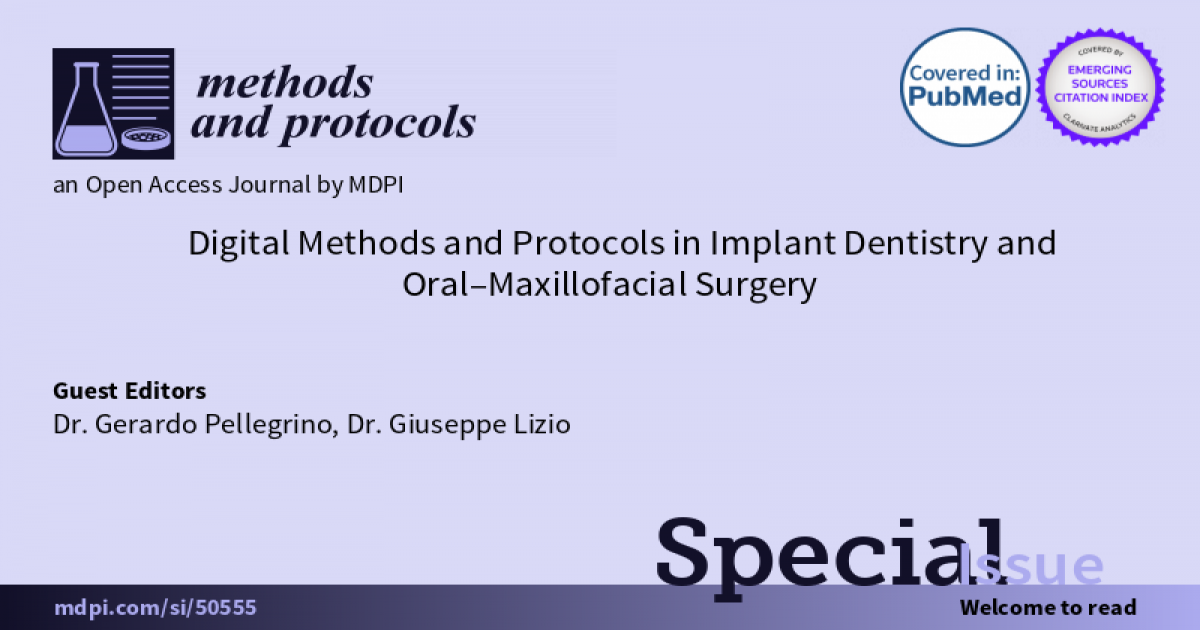Digital Methods and Protocols in Implant Dentistry and Oral–Maxillofacial Surgery
A special issue of Methods and Protocols (ISSN 2409-9279).
Deadline for manuscript submissions: closed (20 September 2021) | Viewed by 34855

Special Issue Editors
Interests: dental implants; digital prosthesis; atrophic maxilla; intra oral scanner; pterygoid implants; zygomatic implants
2. Department of Biomedicine and Neuromotor Sciences, Alma Mater Studiorum University of Bologna, 40125 Bologna, Italy
Interests: dentistry
Special Issues, Collections and Topics in MDPI journals
Special Issue Information
Dear colleagues,
Digital technologies have been introduced into implant dentistry and oral–maxillofacial surgery. This allows a computer-aided approach aiming to simplify clinical procedures, minimizing invasiveness and morbidity for the patient. New protocols and surgical techniques are available applying the latest technologies to oral–maxillofacial surgery and implantology, and clinical and in vitro studies are in progress to validate these. The aim of this Special Issue is to propose innovative methods and protocols related to recent and upcoming technologies applied to implant dentistry and oral–maxillofacial surgery. Literature reviews and clinical and in vitro studies on these topics as well as innovative protocols and reports will be considered for publication in this Special Issue.
Dr. Gerardo Pellegrino
Dr. Giuseppe Lizio
Guest Editors
Manuscript Submission Information
Manuscripts should be submitted online at www.mdpi.com by registering and logging in to this website. Once you are registered, click here to go to the submission form. Manuscripts can be submitted until the deadline. All submissions that pass pre-check are peer-reviewed. Accepted papers will be published continuously in the journal (as soon as accepted) and will be listed together on the special issue website. Research articles, review articles as well as short communications are invited. For planned papers, a title and short abstract (about 100 words) can be sent to the Editorial Office for announcement on this website.
Submitted manuscripts should not have been published previously, nor be under consideration for publication elsewhere (except conference proceedings papers). All manuscripts are thoroughly refereed through a single-blind peer-review process. A guide for authors and other relevant information for submission of manuscripts is available on the Instructions for Authors page. Methods and Protocols is an international peer-reviewed open access semimonthly journal published by MDPI.
Please visit the Instructions for Authors page before submitting a manuscript. The Article Processing Charge (APC) for publication in this open access journal is 1800 CHF (Swiss Francs). Submitted papers should be well formatted and use good English. Authors may use MDPI's English editing service prior to publication or during author revisions.
Keywords
- virtual surgical planning
- computer-aided surgery
- dynamic navigation
- augmented reality
- CAD-CAM manufacturing
- innovative technology
- innovative computer-aided techniques
Benefits of Publishing in a Special Issue
- Ease of navigation: Grouping papers by topic helps scholars navigate broad scope journals more efficiently.
- Greater discoverability: Special Issues support the reach and impact of scientific research. Articles in Special Issues are more discoverable and cited more frequently.
- Expansion of research network: Special Issues facilitate connections among authors, fostering scientific collaborations.
- External promotion: Articles in Special Issues are often promoted through the journal's social media, increasing their visibility.
- e-Book format: Special Issues with more than 10 articles can be published as dedicated e-books, ensuring wide and rapid dissemination.
Further information on MDPI's Special Issue polices can be found here.







